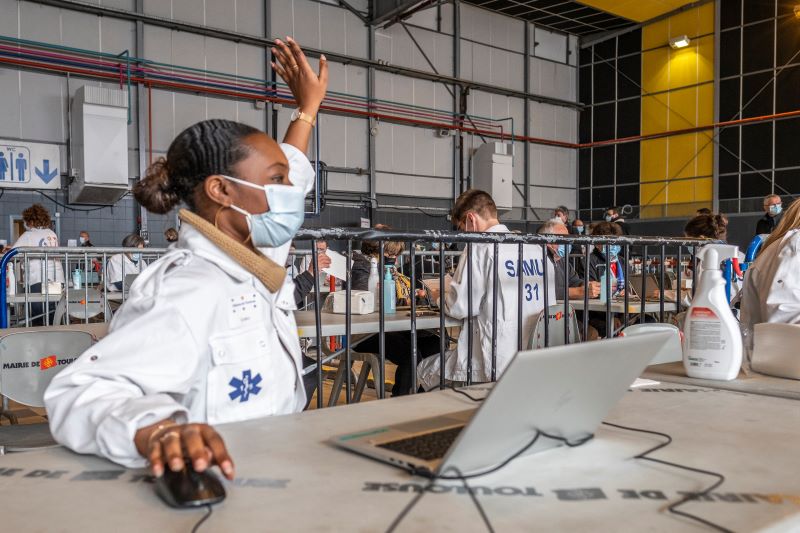How program managers at Dexis support health and health systems in developing nations is a complex process even at the best of times. It requires an adaptive, quality-driven project management approach that keeps pace with rapid changes across a wide range of challenging environments.
In response to this need, the Global Health Technical Assistance and Mission Support Project (GH-TAMS) began in late 2019. GH-TAMS provides USAID’s Bureau for Global Health, Regional Bureaus, and Missions with ready access to high quality short- and medium-term external technical expertise to design, support, and manage programs contributing to the achievement of USG health targets. Yet barely five months after GH-TAMS’ launch, the World Health Organization declared COVID-19 a pandemic. This affected the project’s work on a fundamental level. At the time, COVID-19 was spreading with limited understanding of the virus. National borders were closing. And there was no vaccine in place.
As USAID began responding to and supporting country efforts and partners to address COVID-19, the Bureau for Global Health’s demand for complex, evolving technical assistance and Mission support spiked. GH-TAMS helped address human resource shortages as workload increases and travel ceases came into effect. This high volume continues to this day. Over the past year alone, USAID increased their demand for GH-TAMS support by over 140% and GH-TAMS now works with over 80 missions and GH offices.
Solving implementation problems from this rapid scaling up required strong internal and external communication approaches, which we continue to refine. Thankfully, Dexis already had significant experience from its time as the prime contractor on the predecessor project, Global Health Program Cycle Improvement Project (GH Pro).
“The COVID-19 pandemic was a real trial by fire for the GH-TAMS team,” says Lauren Anneberg, Deputy Director of Projects on GH-TAMS. “We’ve come through it together as a tighter, more skillful, and more capable mechanism.”
Dexis leaned into our best practices with project management and consultant contracting to give GH-TAMS project managers the resources, support, and confidence needed to develop and improve operating practices and processes to meet the demand. We took steps to build the team’s capacity to communicate proactively and effectively with each other and our clients about evolving challenges and proposed solutions. Some key takeaways follow.
1. Recruit managers with strong communication skills. Teams need managers who can assess, anticipate, adapt, and advise in a rapidly changing environment. In practical terms, this means adapting recruitment efforts such as updating job descriptions and adding interview questions about building rapport, communication techniques, and dealing with overtaxed clients and consultants.
2. Share knowledge and strengthen resources. Engage in daily communications, such as team chat groups, provide new and refresher training in adaptive management, and host skill swaps led by all members of the team to disseminate information, build rapport, and strengthen cross-team collaboration.
3. Provide mentoring. Coach team members on communication approaches and expectations. For example, how to anticipate and frame communication with clients to be concise, informative, and actionable. Place strong emphasis on initial onboarding efforts, share sample correspondence examples, and document common challenges and effective solutions.
In addition to these internal efforts, Dexis also worked to advance external communication and processes.
4. Assess and establish communication norms. These will be specific to each client and health consultant. Emphasize the importance of a “needs assessment” at the onset of a new assignment to review roles, set expectations, determine preferred communication styles, and build trust (especially when most consultants are working virtually).
5. Document evolving and country-specific requirements. From travel requirements to security protocols, set up teamwide meetings and trackers to share new guidance as it is established. This includes travel planning checklists, client and project approvals, and pre-departure guidance.
6. Make verbal communication a preferred approach. With the transition to virtual work, over-reliance on email became a norm. When explaining, negotiating, or resolving a complex issue, a call can be more productive and efficient than email.
While managing the surge in requests for support, the GH-TAMS team continued to provide exceptional client support and advance the U.S. Government’s global health priorities and mandates. GH-TAMS received top Contractor Performance Assessment Reporting (CPAR) scores and an unprecedented ceiling increase from $70M to $125M at the midpoint of the project.
GH-TAMS’ strength in adaptive management and emphasis on proactive communication has allowed the project to absorb and grow its portfolio, now nearing 800 consultant assignments. Having been the sought-after mechanism for staffing USAID’s global COVID vaccination efforts around the world, GH-TAMS is well positioned to support the Agency’s new priorities, including the Global Health Security Agenda and the response to other emerging health threats.





